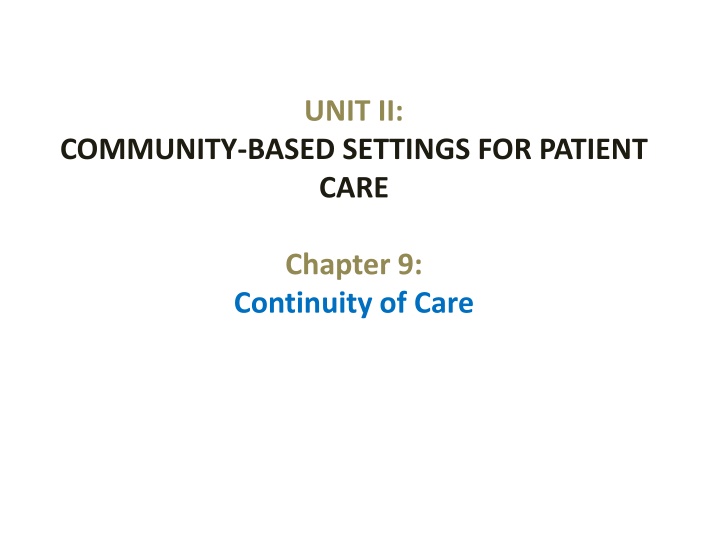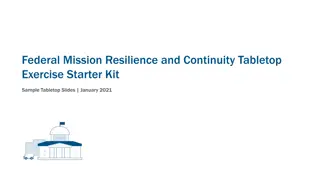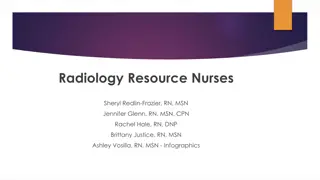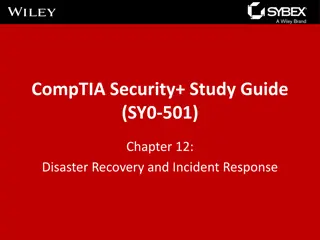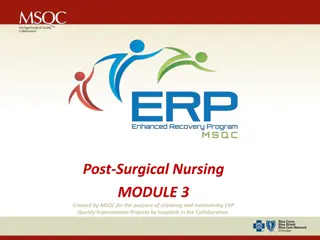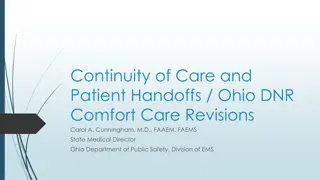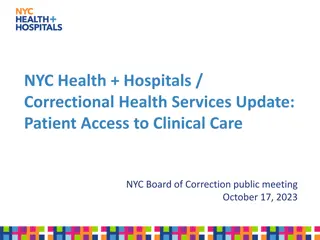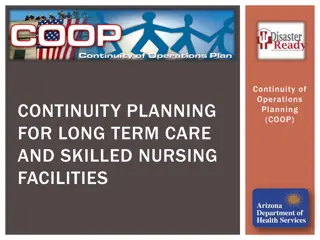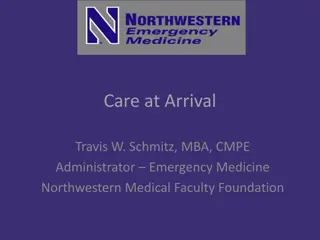Community-Based Patient Care Continuity
This chapter delves into the importance of continuity of care in community-based settings, covering aspects like admission to healthcare facilities, transferring between settings, and discharge planning. The process of continuity of care ensures seamless transitions for patients across different levels of care, promoting uninterrupted and appropriate healthcare provision. The content covers admission to ambulatory care facilities, hospitals, and the significance of the HIPPA privacy rule. It emphasizes the role of healthcare providers in establishing effective relationships with patients, involving them in care planning, and complying with privacy regulations.
Download Presentation

Please find below an Image/Link to download the presentation.
The content on the website is provided AS IS for your information and personal use only. It may not be sold, licensed, or shared on other websites without obtaining consent from the author.If you encounter any issues during the download, it is possible that the publisher has removed the file from their server.
You are allowed to download the files provided on this website for personal or commercial use, subject to the condition that they are used lawfully. All files are the property of their respective owners.
The content on the website is provided AS IS for your information and personal use only. It may not be sold, licensed, or shared on other websites without obtaining consent from the author.
E N D
Presentation Transcript
UNIT II: COMMUNITY-BASED SETTINGS FOR PATIENT CARE Chapter 9: Continuity of Care
Outline 1. Continuity of care 2. Admission to a healthcare setting a. Admission to an ambulatory care facility b. Admission to the hospital c. The HIPPA privacy rule 3. Transferring within & between healthcare settings a. Transfer within the hospital b. Transfer to a long-term care facility 4. Discharge from a healthcare setting a. Discharge planning b. Leaving the hospital against medical advice
Continuity of Care Is a process by which healthcare providers give appropriate, uninterrupted care and facilitate the patient s transition between different settings and levels of care. Within hospital Or Between hospitals To ambulatory or primary care To hospital Discharge Planning Discharge Transfer Admission
Admission to a Healthcare Setting: The patient: New role New environment The nurse: Establish an effective nurse-patient relationship on admission. Please refer to box 9-1 in Ch.9 Collaborate with other healthcare team in meeting the needs of the patient. Orient the patient and involve him/her in a shared planning process.
Admission to an ambulatory care facility May or may not Reception Area Examination Room Same Day Surgery Procedure Go home when recovery is satisfactory Physical assessment Diagnostic tests, immunization, prescription for medication or may undergo minor surgery Complete a short health history and sign a statement acknowledging the HIPPA privacy rule
The HIPPA privacy rule The goal is to assure that health information is protected. Patients: Must sign a statement that they understand the protection of their medical information. Healthcare providers (including students): may only read the records of patients for which they are providing care.
Admission to the Hospital Pre-Admission Laboratory studies, x-rays, admission health history, & physical assessment are usually completed on an outpatient basis before the day of the admission. Admission Office Admitting Unit
Admission to the Hospital Pre-Admission Admission Office Admission information collected & recorded on the admission sheet Wrist band Signing consent form, Advance directives The admitting office notify the unit to which the patient is to be admitted before the patient arrives so the room can be prepared. Admitting Unit
Admission to the Hospital Pre-Admission Admission Office Admitting unit - The nurse welcome the patient and ensure his comfort. - The patient chart & Kardex card are completed. - The nurse complete s the admission assessment (health history & physical assessment). - An inventory of personal belongings and valuable is completed. - Medication reconciliation form is completed.
Transferring Within & Between Healthcare Settings Transfer between healthcare settings Transfer within the hospital Such as: Emergency room to a hospital room. Intensive care unit to a hospital room (and vice versa). One unit to another. One room to another room on the same unit. Such as: To and from acute care settings and long-term settings. From acute care setting to their homes. From ambulatory care settings to acute care settings.
Transfer Within the Hospital The nurse should ensue the following: Personal belongings must be moved to the new room. The patient s chart and Kardex card are moved to the new unit. Other hospital departments (e.g. dietary, pharmacy) must be notified of the transfer. The nurse in the original area gives a verbal report about the patient to the nurse in the new area.
Transfer to Long-Term Facility The patient is discharged from the hospital. The Nurse ensures that the following is sent to the long-term facility: A copy of the chart (depending on the physician s preference and the agency s protocol). All the patient belongings. Prescriptions and appointment cards for return visits to the physician s office. In most instances, a detailed assessment and care plan. The nurse at the hospital often provides a verbal report to the nurse at the long-term care facility.
Discharge from a Healthcare Setting Patients are discharged from a healthcare facility when: 1. The expected outcomes of care are met. 2. The patient or caregiver have the necessary knowledge and skills to provide care.
Discharge Planning Purpose: To ensure that the patient and family needs are consistently met as the patient moves from the acute care setting to care at home. Effective discharge planning begins on admission
Discharge Planning Essential components: Assessing the strength & limitations of the patient, the family or support person, and the environment. Implementing and coordinating the plan of care. Considering individual, family, and community resources. Evaluating the effectiveness of care.
Discharge Planning Factors to assess: Health data (age, gender, current health problem, functional limitations, etc.) Personal data (ask the patient: how do you feel about being discharged? What are your expectations for recovery? Etc.) Caregivers (ask the caregiver: do you live with the patient? What are your expectations and fears about providing care at home?) Environment (assess the home, whether the patient will be able to use assistive devices, or bathroom facilities safely, if hot water, & heat are available? Etc.) Financial & support resources (discuss expenses of prescribed care, including dressing supplies, medications, equipment, & special food etc.)
How would the nurse coordinate a discharge plan? (discharge planning example p. 165) The physician must be consulted for diet, medication, other treatments, and home health orders. The dietitian needs to counsel the patient & caregiver on diet restrictions. The social worker should be called for financial assessment and assistance. .
Assignment # 5 Choose a type of healthcare setting where you (or one of your family members) have received care. How many healthcare providers did you come in contact with? What were your concerns on admission? How did those concerns differ from those experienced on discharge?
